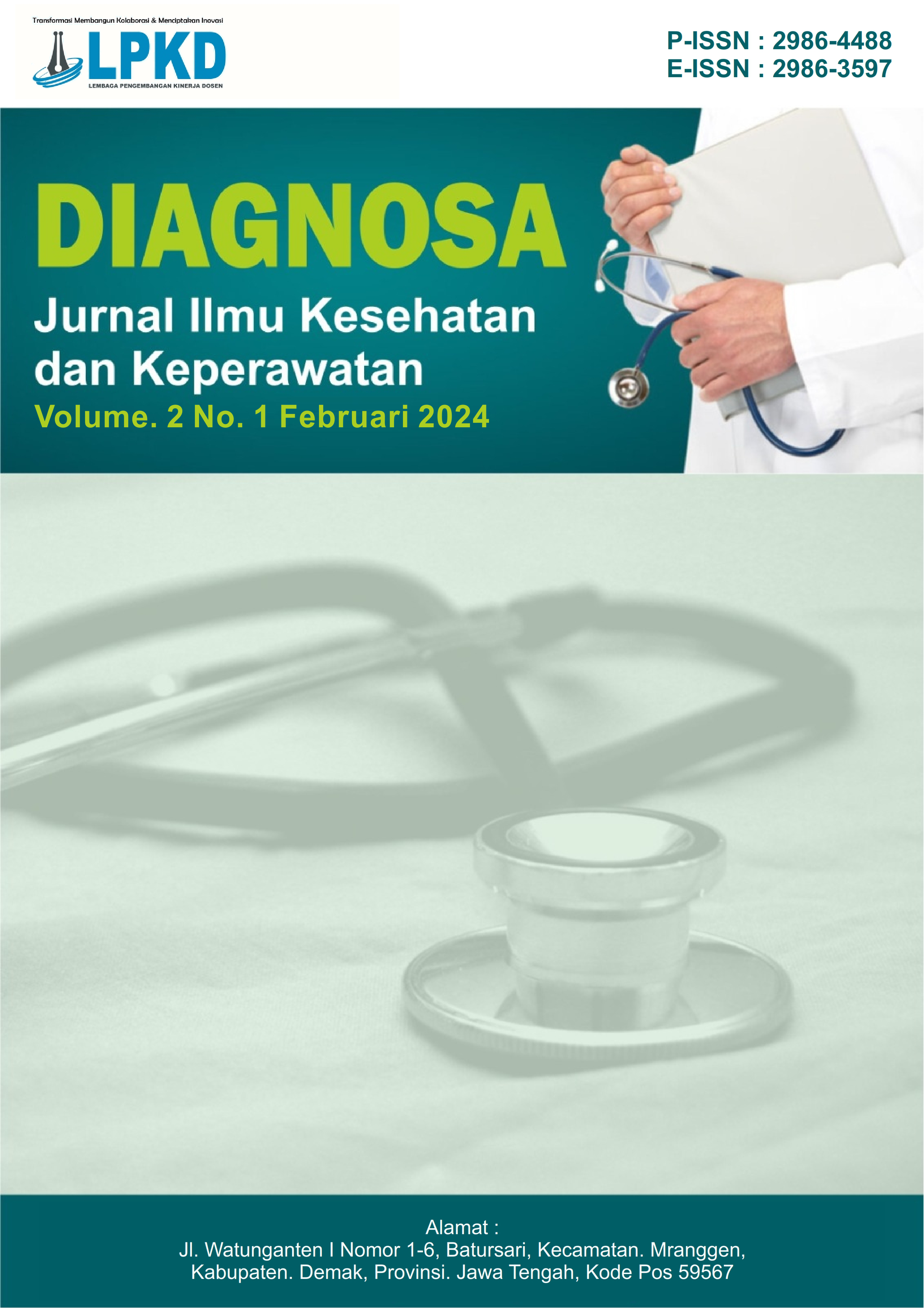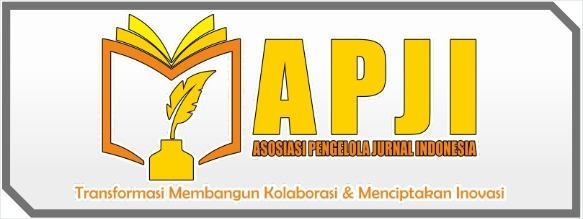Hubungan Anemia Dalam Kehamilan Dengan Kejadian Bayi Berat Badan Lahir Rendah BBLR Di RSUD Kabupaten Tangerang
DOI:
https://doi.org/10.59581/diagnosa-widyakarya.v2i1.2738Keywords:
LBW babies, AnemiAbstract
Babies with Low Birth Weight (LBW) are a health problem for babies and can affect the number of Infant Mortality Rates (IMR). Another factor that can cause LBW is the hemoglobin level of pregnant women or anemia in pregnant women. Anemia in pregnant women can cause mortality and morbidity in both mother and baby. Research objective: to determine the relationship between anemia in pregnancy and the incidence of LBW babies in RSUD Kabupaten Tangerang. Research method: this study used an analytic observational design with a retrospective cross-sectional approach. The sample for this study were all babies born with a birth weight < 2500 grams for the September-December 2022 period of 123 babies. The sampling method used in this study is the total sampling method. Data was obtained by filling out a note sheet from the search results of the respondent's medical records. Univariate and bivariate data analysis using the chi-square test. The results of the study: of the 123 respondents, the majority were 75 respondents (61%) with mild anemia and 97 respondents (61%) with LBW. There was a relationship between anemia in pregnancy and the incidence of LBW babies with a p value of 0.000 <α (0.05). Conclusions and suggestions: There was a relationship between anemia in pregnancy and the incidence of LBW babies in RSUD Kabupaten Tangerang. Hospitals are advised to improve nursing services, especially health education to increase pregnant women's knowledge about the importance of iron during pregnancy in an effort to prevent anemia during pregnancy, one of which can cause low birth weight babies.
References
Adam, I., & Ali, A. A. (2016). Anemia during pregnancy. Nutritional Deficiency, 111–126.
Aditianti, & Djaiman, S. P. H. (2020). Meta Analisis: Pengaruh Anemia Ibu Hamil terhadap Berat Bayi Lahir Rendah. Jurnal Kesehatan Reproduksi, 11(2), 163–177. https://doi.org/10.22435/kespro.v11i2.3799.163-177
Aini, E. N. (2020). Pemeriksaan kadar hemoglobin dan upaya penanganan anemia pada remaja di smas unggulan bppt darus sholah jember 1. Jurnal Idaman, 4(2), 77–83.
Amiruddin, N. A. (2022). Hubungan anemia dalam kehamilan dengan angka kejadian Bayi Berat Lahir Rendah (BBLR) di Puskesmas Tamangapa kota Makassar (Vol. 4). Fakultas Kedokteran dan Ilmu Kesehatan UIN Alauddin Makassar.
Arikunto, S. (2016). Prosedur Penelitian: Suatu Pendekatan Praktik. Jakarta : Rineka Cipta.
Astutik, R. Y., & Ertiana, D. (2018). Buku Anemia dan Anemia dalam Kehamilan. Jember: CV. Pustaka Abadi.
Bakta, I. M. (2022). Hematologi Klinik Edisi 2. Jakarta: EGC.
Cunningham, F. G., Leveno, K. J., Bloom, S. L., Dashe, J. S., Hoffman, B. L., & Spong, C. Y. (2021). Obstetrics Williams 25th Edition. Jakarta : EGC.
Dinas Kesehatan Kabupaten Tangerang. (2020). Profil Kesehatan Kabupaten Tangerang Tahun 2020.
Dinas Kesehatan Provinsi Banten. (2020). Profil Kesehatan Provinsi Banten Tahun 2020.
Dinkes Provinsi Banten. (2021). Profil Kesehatan Provinsi Banten Tahun 2021.
Hansen, M., Singh, G., Barzi, F., Brunette, R., Howarth, T., Morris, P., Andrews, R., & Kearns, T. (2020). Maternal Anaemia in Pregnancy: A Significantly Greater Risk Factor for Anaemia in Australian Aboriginal Children than Low Birth Weight or Prematurity. Maternal and Child Health Journal, 24(8), 979–985. https://doi.org/10.1007/s10995-020-02913-7
Kemenkes, R. (2021). Profil Kesehatan Indonesia. Kementerian Kesehatan RI.
Kemenkes RI. (2019). Riset Kesehatan Dasar (Riskesdas) Tahun 2018.
Kemenkes RI. (2020). Profil Kesehatan Indonesia Tahun 2019. Jakarta : Kementerian Kesehatan RI.
Kusumawardani, F., Prabowo, A. Y., & Rodiani. (2018). Hubungan anemia maternal dengan depresi postpartum. Jurnal Majority, 7(2), 267–272.
Lestari, E. S. (2021). Hubungan status gizi dan anemia dengan kejadian bayi berat badan lahir rendah di Rumah Sakit Dustira Cimahi tahun 2018. Jurnal Health Sains, 2(2), 161–171.
Manuaba. (2017). Ilmu Kebidanan, Penyakit Kandungan, dan KB. In Ilmu Kebidanan, Penyakit, Kandungan, dan KB. Jakarta : EGC.
Mardha, M. S., & Syafitri, E. (2020). Factors Affecting Anemia in Pregnant Women in Ratna Clinic. Jurnal Proteksi Kesehatan, 9(2), 16–24. https://jurnal.pkr.ac.id/index.php/JPK/article/view/291
Maternity, D., Anjani, A. D., & Evrianasari, N. (2018). Asuhan Kebidanan: Neonatus, Bayi, Balita & Anak Prasekolah. Yogyakarta: Penerbit ANDI.
Maywati, S., & Novianti, S. (2020). Kajian Karakteristik Individu Sebagai Faktor Risiko Kejadian Anemia Pada Ibu Hamil (Studi Di Puskesmas Karanganyar Kota Tasikmalaya). Jurnal Kesehatan Komunitas Indonesia, 16(2), 202–208.
Notoatmodjo, S. (2018). Metodologi Penelitian Kesehatan. Jakarta : Rineka Cipta.
Polit, D. F., & Beck, C. T. (2018). Essentials of Nursing Research Appraising Evidence for Nursing Practice (Ninth Edition). Philadelphia: Lippincott Williams & Wilkins.
Prawirohardjo, S. (2016). Ilmu Kebidanan Sarwono Prawirohardjo. Edisi Ke-4. Jakarat : Yayasan Bina Pustaka Sarwono Prawirohardjo.
Proverawati, A., & Ismawati, C. (2014). Berat Badan Lahir Rendah (BBLR). Yogyakarta : Nuha Medika.
Rahadinda, A., Utami, K. D., & Reski, S. (2022). Hubungan anemia pada ibu hamil dengan kejadian BBLR di RSUD Abdul Wahab Sjahranie Samarinda. Formosa Journal of Science and Technology, 1(5), 421–434. https://doi.org/10.55927/fjst.v1i5.1219
Roosleyn, I. P. T. (2016). Strategi dalam penanggulangan pencegahan anemia pada kehamilan. Jurnal Ilmiah Widya, 3(3), 1–9.
Sabri, L., & Hastono, S. P. (2018). Statistik kesehatan. Jakarta : Raja Grafindo Persada.
Setyarini, D. I., & Suprapti. (2016). Asuhan Kebidanan Kegawatdaruratan Maternal Neonatal (Cetakan Pe). Jakarta : Kementerian Kesehatan RI. https://www.ptonline.com/articles/how-to-get-better-mfi-results
Sudarti, & Fauziah, A. (2014). Asuhan Neonatus Risiko Tinggi dan Kegawatan. Yogyakarta : Nuha Medika.
Sugiyono. (2019). Metode Penelitian Kuantitatif Kualitatif dan R&D. Bandung : Alfabeta.
Tarwoto, & Wasnidar. (2021). Buku Saku : Anemia pada Ibu Hamil, Konsep dan Penatalaksanaan. Jakarta: Trans Info Media.
UNICEF. (2019). Unicef-WHO Low Birthweight Estimates Levels and Trend 2000-2015. https://doi.org/10.1016/S2214-109X(18)30565-5
UNICEF. (2021). United Nations Inter-Agency Group for Child Mortality Estimation (UN IGME), Report 2020. Levels and Trends in Child Mortality.
Wahyuni, S., Putri, A. R. A., & Imbir, S. (2022). Hubungan anemia dalam kehamilan dengan kejadian bayi BBLR (Berat Badan Lahir Rendah) di RSUD Supiori. Jurnal Kebidanan Kestra (Jkk), 4(2), 108–112. https://doi.org/10.35451/jkk.v4i2.1051
Pregnancy With The Event Of LBW Babies (Low Birth Weight) at Supiori Hospital. Jurnal Kebidanan Kestra (Jkk), 4(2), 108–112. https://doi.org/10.35451/jkk.v4i2.1051
Widiyanto, J., & Lismawati, G. (2019). Maternal age and anemia are risk factors of low birthweight of newborn. Enfermeria Clinica, 29, 94–97. https://doi.org/10.1016/j.enfcli.2018.11.010
Wijayanti, D. R., MArgono, & Muslihatun, W. N. (2020). Correlation Between Maternal Weight Gain During. Poltekes Kemenkes Yogyakarta.













